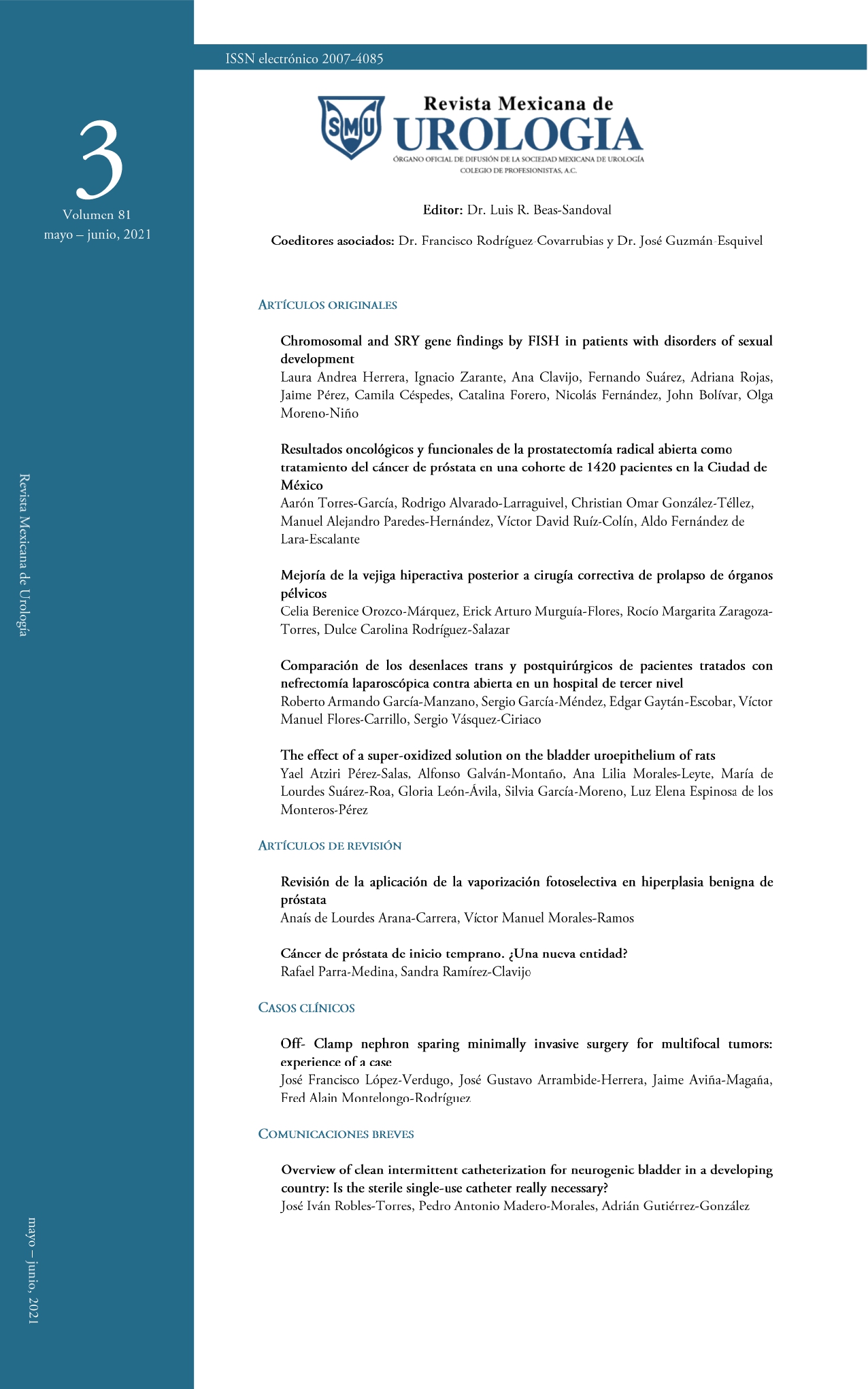Improvement of overactive bladder after corrective surgery for pelvic organ prolapse
DOI:
https://doi.org/10.48193/revistamexicanadeurologa.v81i3.749Keywords:
Overactive bladder, pelvic organ prolapse, corrective surgery, OAB-V8Abstract
Aim: To evaluate improvement in overactive bladder, after corrective surgery for pelvic organ prolapse.
Methodology: A descriptive cross-sectional study included 215 patients with overactive bladder and pelvic organ prolapse that underwent corrective surgery for the prolapse. The OAB-V8 questionnaire was applied to the patients preoperatively and 3 months after surgery. The results were reported in frequency and percentage tables and the variables were compared using inferential statistics (95% CI, p<0.05).
Results: There was partial symptom improvement in 89.3% (192) of the patients, complete improvement in 2.3% (5), and a worsening of symptoms in 8.4% (18). No association with the postoperative result was found, with respect to the initial grade of prolapse or the type of surgery performed.
Limitations: The study was retrospective, nonrandomized, and carried out at a single center. None of the patients had a urodynamic evaluation.
Originality or value: Overactive bladder affects 33 million women. Pelvic organ prolapse presents in 50% of women after childbirth and 40% of those patients have overactive bladder. Even though overactive bladder is treated medically, its symptoms have improved after the surgical correction of pelvic organ prolapse.
Conclusions: Surgical treatment of pelvic organ prolapse provided satisfactory results in improving overactive bladder symptomatology, with few complications. There were no differences, regarding prolapse grade or the surgical technique employed.
References
Abrams P, Cardozo L, Fall M, Griffiths D, Rosier P, Ulmsten U, et al. The standardisation of terminology in lower urinary tract function: report from the standardisation sub-committee of the International Continence Society. Urology. 2003;61(1):37–49. doi: 10.1016/s0090-4295(02)02243-4
García-Sánchez D, Gutiérrez-González A, Pérez-Ortega R, Gastelum-Félix LA, Reyes-Gutiérrez MÁ. Frecuencia de la vejiga hiperactiva en médicos generales. Revista Mexicana de Urología. 2014;74(2):84–7. doi: 10.1016/S2007-4085(15)30017-3
Asociación Española de Urología. Guía Vejiga Hiperactiva de la AEU. España: Asociación Española de Urología; 2014 p. 62.
Espuña Pons M, Puig Clota M, Rebollo Álvarez P. Validación de la versión en español del "Cuestionario de Autoevaluación del Control de la Vejiga (CACV): Un nuevo instrumento para detectar pacientes con disfunción del tracto urinario inferior. Actas Urológicas Españolas. 2006;30(10):1017–24.
Ann Gormley E, Deborah J, Lightner, Kathryin L, Burgio, Toby C. Diagnóstico y Tratamiento de Vejiga Hiperactiva (No Neurogénica) en Adultos: Guía AUA/SUFU. Estados Unidos: Asociación Urológica Americana (AUA); 2019.
Haylen BT, Maher CF, Barber MD, Camargo S, Dandolu V, Digesu A, et al. An International Urogynecological Association (IUGA) / International Continence Society (ICS) joint report on the terminology for female pelvic organ prolapse (POP). Int Urogynecol J. 2016;27(2):165–94. doi: 10.1007/s00192-015-2932-1
B
Maher C, Feiner B, Baessler K, Christmann-Schmid C, Haya N, Brown J. Surgery for women with anterior compartment prolapse. Cochrane Database Syst Rev. 2016;11:CD004014. doi: 10.1002/14651858.CD004014.pub6
Sociedad Española de Ginecología y Obstetricia. Prolapso de los órganos pélvicos. Prog Obstet Ginecol. 2020;63(1):54–9.
Jelovsek E. Pelvic organ prolapse in women: Choosing a primary surgical procedure. UpToDate. 2018
Vera Veliz, A, Domínguez Argomedo, R, Acuña Madrid, J, Orellana Sepulveda, S, Hassi Roman, M, Iglesias Urrutia, T. Vejiga hiperactiva y cistocele: impacto de la colposacropexia en la mejoría de los síntomas urinarios. Revista Chilena de Urología. 2017;82(3).
Frigerio M, Manodoro S, Cola A, Palmieri S, Spelzini F, Milani R. Risk factors for persistent, de novo and overall overactive bladder syndrome after surgical prolapse repair. Eur J Obstet Gynecol Reprod Biol. 2019; 233:141–5. doi: 10.1016/j.ejogrb.2018.12.024
Tomoe H. Improvement of overactive bladder symptoms after tension-free vaginal mesh operation in women with pelvic organ prolapse: Correlation with preoperative urodynamic findings. Int J Urol. 2015 Jun;22(6):577–80. doi: 10.1111/iju.12744
Baessler K, Maher C. Pelvic organ prolapse surgery and bladder function. Int Urogynecol J. 2013;24(11):1843–52. doi: 10.1007/s00192-013-2175-y
Liedl B, Inoue H, Sekiguchi Y, Haverfield M, Richardson P, Yassourides A, et al. Is overactive bladder in the female surgically curable by ligament repair? Cent European J Urol. 2017;70(1):53–9. doi: 10.5173/ceju.2017.938
Secretaría de Salud. Ley General de Salud. Diario Oficial de la Federación 1992.
Asociación Médica Mundial. Declaración de Helsinki de la Asociación Médica Mundial Principios éticos para las investigaciones médicas en seres humanos. 1964.
Kleeman S, Karram M. Síndrome de vejiga hiperactiva y nicturia. In: Uroginecología y cirugía reconstructiva de la pelvis. 3rd ed. España: Elsevier; 2008.
Duport C, Duperron C, Delorme E. Anterior and middle pelvic organ prolapse repair using a six tension-free strap low weight transvaginal mesh: long-term retrospective monocentric study of 311 patients. J Gynecol Obstet Hum Reprod. 2019;48(3):143–9. doi: 10.1016/j.jogoh.2018.11.008
de Boer TA, Kluivers KB, Withagen MIJ, Milani AL, Vierhout ME. Predictive factors for overactive bladder symptoms after pelvic organ prolapse surgery. Int Urogynecol J. 2010;21(9):1143–9. doi: 10.1007/s00192-010-1152-y
Malanowska E, Starczewski A, Bielewicz W, Balzarro M. Assessment of Overactive Bladder after Laparoscopic Lateral Suspension for Pelvic Organ Prolapse. BioMed Research International. 2019;2019:e9051963. doi: 10.1155/2019/9051963
Takazawa N, Fujisaki A, Yoshimura Y, Tsujimura A, Horie S. Short-term outcomes of the transvaginal minimal mesh procedure for pelvic organ prolapse. Investig Clin Urol. 2018;59(2):133–40. doi: 10.4111/icu.2018.59.2.13
Hafidh BA, Chou Q, Khalil MM, Al-Mandeel H. De novo stress urinary incontinence after vaginal repair for pelvic organ prolapse: one-year follow-up. Eur J Obstet Gynecol Reprod Biol. 2013;168(2):227–30. doi: 10.1016/j.ejogrb.2012.12.029
Diez-Itza I, Aizpitarte I, Becerro A, Sarasqueta C. Incidence of Overactive Bladder after Vaginal Hysterectomy and Associated Repairs for Pelvic Organ Prolapse. GOI. 2009;68(1):65–70. doi: 10.1159/000215711
Foster RT, Barber MD, Parasio MFR, Walters MD, Weidner AC, Amundsen CL. A prospective assessment of overactive bladder symptoms in a cohort of elderly women who underwent transvaginal surgery for advanced pelvic organ prolapse. Am J Obstet Gynecol. 2007;197(1):82.e1-4. doi: 10.1016/j.ajog.2007.02.049
Globerman D, Robert M. Heterogeneity in post-intervention prolapse and urinary outcome reporting: a one-year review of the International Urogynecology Journal. Int Urogynecol J. 2015;26(9):1373–8. doi: 10.1007/s00192-015-2720-y






